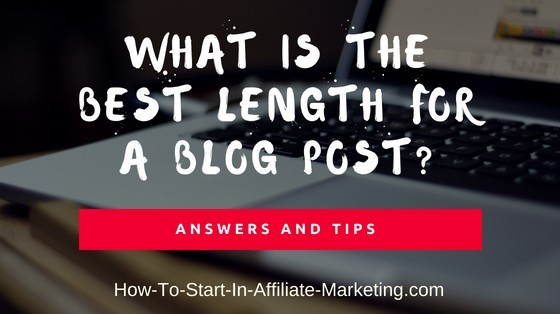
The answer to the question, “what is the best length for a blog post?” is the same as the old adage about a piece of string. It really depends on a number of things including:
- the type of post
- the intended audience
- your style
- your purpose in writing the post
- the problems you are solving for your audience
- the time you have
There is no ‘magic number’ that all posts have to be although you will find guidance out there that will recommend posts of a certain length.
When I first dabbled in blogging and content marketing a few years ago, there was a consensus that articles needed to be about 500 words. Since then, it seemed to rise by common consent to 800, then 1000 and some people even suggest 1500-2000 words is now expected by the search engines.

The truth is that whilst search engine optimisation (SEO) and ranking was establishing itself in earlier times, the length of a post could be a measure that search engines used to measure the usefulness (and therefore rank) of a post. However, times have changed and the algorithms used by search engines nowadays are far more sophisticated and they can rank a post based on many more criteria than the number of words you write.
That said, if you are still struggling with knowing how many words you should write for a particular post, answering the following questions will give you a clearer idea.
1. What kind of post are you writing?
This is the first question that will determine the appropriate length of your post. Are you writing a travel blog, recipe, ‘how-to-so’ post, information, education, lifestyle blog? The list is endless. Think about the different length of posts you get in a magazine. Some are very short advertisements; some are answering ‘agony aunt’ type questions and some are in depth, editorials full of information and resources.
Writing a blog or article is now different. The length of the post will be determined in part by the amount of information you have to get across to your reader. If you have a lot of information, then the post will necessarily be longer but there are tips and tricks (see below) to help your reader so they do not feel they are struggling though a copy of Homer’s “The Odyssey”.
Sometimes you can get away with writing only a short review and the information you are giving is only about 300 words. In that case you might feel that you post is too short. You could then combine things together for example, and write a ‘best of” or “top 5” items of whatever you are reviewing to extend your post and help your reader.
Become and affiliate marketer by taking the Wealthy Affiliate free online course here
2. Who will read your article?
This is another key question that you need to know the answer to not only answer the question about article length, but also to improve your writing per se.
Knowing your audience is crucial to any kind of communication on any level because it determines the words you use, the style you write in and ultimately whether you will be successful in getting your message across.
In everyday life, you would not talk to a 7-year old in the same way as your mother, or your peers or work colleagues for that matter. You have developed an appropriate way of communicating with each group separately. This is the same for blogging.
Busy mums may have less time than students; working adults looking for a part-time income may have even less time but need concise, high-quality information quickly. A teenager looking for relationship advice will be a whole new kettle of fish. I realise that these are generalisations and there will always be exceptions to the rule, but the key thing here is to KNOW YOUR AUDIENCE FIRST. Once you do this, it will be easier to tailor your posts towards them and their needs.

3. What problems are you solving for your audience?
This is closely related to point 2. You need to adopt the mindset of becoming a helper. Your first thought should be to understand how to solve a problem for your audience, not how to make money. The money will come, but only if you are giving something of value to your readers.
And that means, solving their problems.
It can be a simple problem such as “who can I trust in the local area to fix my plumbing?”; “where can I take the kids this weekend?” or “what’s a good set of pruning shears?”. It could also be a much more complex problem related to relationships, money-problems or self-improvement that requires a more detailed explanation of even a series of articles.
Knowing the problem you are solving in each post you write is vital so before you put pen to paper or fingers to keyboards, make sure you are really clear about the problem you are solving, and then make sure you solve it in your post.
4. What is the style of writing needed?

This style needed will come out of your answer to questions 2 and 3 and is entirely related to knowing your audience and their needs. Most posts should be written in a conversational style, engaging the reader and making them think that you are talking directly to them.
However, there are post which are simple ‘how-to-do-something’ posts in which case you need a clear, jargon-free, concise style. Images, diagrams or video may help you here and be appropriate too.
Remember that anecdotes and stories about your own personal experience may be very relevant in a travel blog or review post, but might seem out of place if you are writing a factual, academic post of a scientific or technical nature.
The tip here is ‘horses for courses‘ – make sure your style of writing fits what your audience expect.
What next?
Once you have answered the questions above, you should have a much better idea of the length, content and writing style that is needed for your particular article. And this will change from one article to the next.
I’ve listed some tips below to help you either condense or bulk-out your content if necessary which you may find useful when writing your next article.
1. Do your research – what are others doing?
A quick way to work out the style, average length and appropriate vocabulary level for your article is to research what others in your niche are doing. This is easily done by using a search engine and your keywords and just spending a few minutes looking around at what else is out there.
This is not copying and you should never do that, but do the research so that you know what your audience will expect. You may find a particular layout you like or a template for a product review post for example, that you can use in your writing and which will help you with word counts and headings.
I’m a great advocate for research as I have found it invaluable in providing usable and useful information so make sure you do your research well.

2. Monitor what works for your audience and you
The second tip here is to really monitor your posts and see what is working for you and your audience. There is no harm in experimenting with different post lengths on different subjects and then reviewing the impact that these posts are having.
Are they being read? If so, by who? What is the average bounce rate of the article. You can find many of these things out by using analytics tools such a Google Analytics, Bing Webmaster Tools or other free analytics tools such as Clicky or Open Web Analytics.
If you are really serious about analysing your data, you can pay for more detailed results from providers such as Mouseflow or Clicktale. Whatever you do, analysing how your readers behave when reading your posts is important information for building on your successes going forward.
Remember you can also get feedback on your posts directly by asking for comments and responding to the replies you get. After all, if you don’t ask, you don’t get, so be brave and see what people think about your posts.
3. Use pictures, quotes, video, bullet points
‘A picture is worth a thousand words’ so they say and articles that are visual are easier to digest and appeal to the different learning styles that users have; visual, auditory and kinesthetic (hands-on).
By the same token, including audio-visual content in the form or a video or audio file can also enhance your post and are often invaluable in ‘how-to’ posts as we all like to be shown how to do something rather than just reading the instructions. How much easier would it be to put together those self-assembly furniture pieces if they came with a video?
Think also about making your content readable by using:
- short paragraphs
- enough space between paragraphs and headings
- images
- quotes
- bullet points
- horizontal lines to separate ideas
These will all add to the readability of the post and the length of the post will seem immaterial if it is easy-to-read and the user needs the information.
4. Split up or combine things
If you feel that your posts are either too long or too short when you have taken all the above things into account, then you can always either split them into 2 or more parts (remembering to link from one to the other); or combine them with other information too.
There are no set rules so feel free to make your articles work for you and your audience.
Join Wealthy Affiliate now to get free training and start your own online business
Remember: The QUALITY of the content is key, not the length
Finally, remember that if you know your audience and are solving a problem for them, then they will read your content if it is good quality information. As we began saying, the length of the post is really dependent on a number of factors and no two posts will be the same. But if you follow the tips and ideas above, then you should be able to discern an appropriate length for each of your posts.
 You will not get a black mark for writing posts that are over or under length and you can always revisit and change your posts at a later date if you feel it will enhance the post.
You will not get a black mark for writing posts that are over or under length and you can always revisit and change your posts at a later date if you feel it will enhance the post.
I hope you have found the information useful, if so, please do leave us a comment below, so that we can get our own feedback and let us know what else you would like to see on the site.
Thank you.
RELATED ARTICLES
How to write for blogs: 10 tips for beginners
6 things to do before you start an online business website




hi Gail,
thank you for the great info, your post as usual is so helping and straight to the point, full of essential information that i personally find it very supportive.
again thanks for sharing
Hi Ronda.
Good to see you back and thank you for your kind comments. I’m glad you found the post useful and hopefully you will check out some of my other posts about blogging and writing too – did you see the one about getting over writer’s block?
now i will 🙂
thank you again Gail
Yes. I did find that useful. I’ve often wondered about the length of a post and thought that sometimes a short concise one would be more appealing to readers than an overly dawn out one. Thanks !
Hi Les. Thanks for reading and then leaving a comment. Your feedback is appreciated and I’m glad you found the post useful. It really is a question of what fits your content and audience best and sometime short and snappy it where it’s at! 🙂 You might also like some of my other posts on writing such as my WordPress tips article that is useful for people just starting out too.
I always wondered the lengths of posts however I think the quality is the most important thing. I actually wonder something about it. Does the length depend on the subject? If I write about a sports event it will not be that long but I know there are some articles in money making niche which last more than 5000 words. What is your take on this?
Hi Furkan. I think that quality is everything in writing. No one wants to read an article that is full of typos or badly worded. The quality of the information and the way you put it across is very important. No point in just writing for the sake of writing – that would fall into the category of ‘fool’ I think if you read the quote in the post. I think that articles will find their own natural length and hopefully you will remember to write for your own audience and their expectations so that you are fulfilling their needs first. I don’t think you can go wrong if you keep those things in mind.
I usually find that regardless of the length, although you need it reasonably long, it is the information contained inside is the important part. You can explain something within the first 300 words and the rest of the blog is just making up the length without explaining much. I think that quality prevails over quantity.
Hi Andrew. I agree that quality is very important with everything to do with blogging and that we should really concentrate on getting out quality information that will solve our reader’s problems. That’s why the blog length depends on just those things. Some people like to read the news headlines only (I am one of those) and others like to digest all the comments and opinions that are proffered as well. There’s no judgement here, but just noticing again that it’s ‘horses for courses’. Thanks for reading and leaving a comment. Gail
I completely echo what you said. When I first dipped my toe in the water a couple years ago, it was 500 words. All of my posts now exceed 1,000 words but it’s totally relevant to what I’m writing about. I also think there’s a place for shorter content (500 words), but they need to reference other posts on your site for more info. I think that’s where the “relevant content” comes in.
Thanks for sharing!
Hi Dave. You’re so right. Content marketing (like everything else) changes with the times and those people in the industry need to change and adapt with it. I really love my writing so never struggle to find words (as my family will tell you!) The main thing is still serving the customer though, even in an online business. All the best for your own sites and thank you for reading. Gail